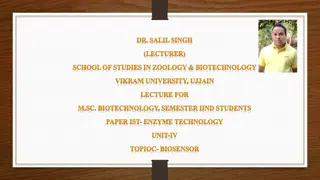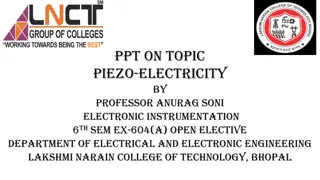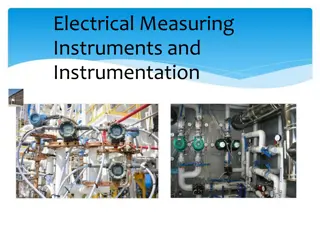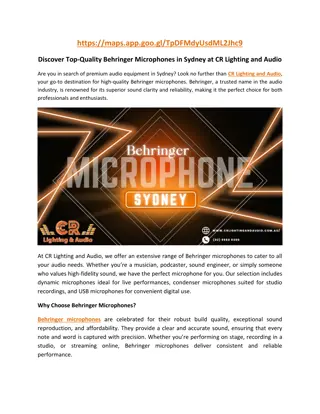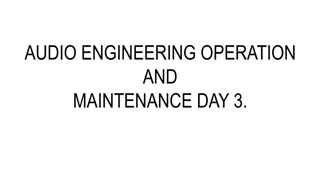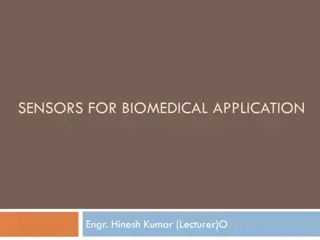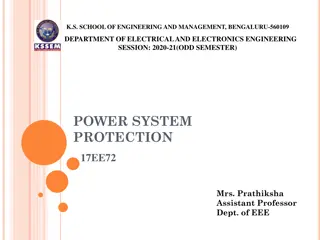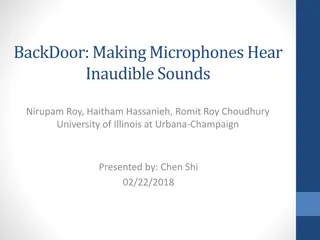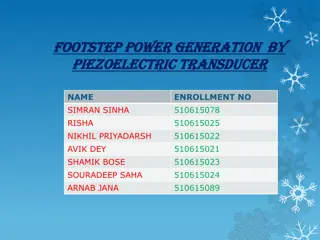Understanding Acoustical Transducers: Microphones and Loudspeakers
This tutorial explores acoustical transducers, focusing on microphones and loudspeakers. It covers transduction, principles of microphones and loudspeakers, as well as acoustics and psychoacoustics. Also discussed are the basics of sound, sound propagation, and the relationship between wavelength and frequency.
Download Presentation

Please find below an Image/Link to download the presentation.
The content on the website is provided AS IS for your information and personal use only. It may not be sold, licensed, or shared on other websites without obtaining consent from the author. Download presentation by click this link. If you encounter any issues during the download, it is possible that the publisher has removed the file from their server.
E N D
Presentation Transcript
A Tutorial on Acoustical Transducers: Microphones and Loudspeakers Robert C. Maher Montana State University EELE 417/517 Acoustics and Audio Engineering Fall 2016
Outline Introduction: What is sound? Microphones Principles General types Sensitivity versus Frequency and Direction Loudspeakers Principles Enclosures Conclusion 2
Transduction Transduction means converting energy from one form to another Acoustictransduction generally means converting sound energy into an electrical signal, or an electrical signal into sound Microphones and loudspeakers are acoustic transducers 3
Acoustics and Psychoacoustics Mechanical to Acoustical Electrical to Psychological Acoustical propagation (reflection, diffraction, absorption, etc.) Mechanical to Electrical (nerve signals) Acoustical to Mechanical 4
What is Sound? Vibration of air particles A rapid fluctuation in air pressure above and below the normal atmospheric pressure A wave phenomenon: we can observe the fluctuation as a function of time and as a function of spatial position 5
Sound (cont.) Sound waves propagate through the air at approximately 343 meters per second Or 1125 feet per second Or 4.7 seconds per mile 5 seconds per mile Or 13.5 inches per millisecond 1 foot per ms The speed of sound (c) varies as the square root of absolute temperature Slower when cold, faster when hot Ex: 331 m/s at 32 F, 353 m/s at 100 F 6
Sound (cont.) Sound waves have alternating high and low pressure phases Pure tones (sine waves) go from maximum pressure to minimum pressure and back to maximum pressure. This is one cycle or one waveform period (T). T 7
Wavelength and Frequency If we know the waveform period and the speed of sound, we can compute how far the sound wave travels during one cycle. This is the wavelength ( ). Another way to describe a pure tone is its frequency (f): how many cycles occur in one second. 8
Wave Relationships c = f [m/s = /s m] T = 1/f = T c c = speed of sound [m/s] f = frequency [ /s] = wavelength [ m ] T = period [ s ] Note: high frequency implies short wavelength, low frequency implies long wavelength 9
Sound Amplitude and Intensity The amount of pressure change due to the sound wave is the sound amplitude The motion of the air particles due to the sound wave can transfer energy The rate at which energy is delivered by the wave is the sound power [ W (watts)] The power delivered per unit area is the sound intensity [ W/m2 ] 10
Microphone Principles Concepts: Since sound is a pressure disturbance, we need a pressure gauge of some sort Since sound exerts a pressure, we can use it to drive an electrical generator Since sound is a wave, we can measure simultaneously at two (or more) different positions to figure out the direction the wave is going 11
Microphone: Diaphragm and Generating Element Diaphragm: a membrane that can be set into motion by sound waves Sensitivity: how much motion from a given sound intensity Generating Element: an electromechanical device that converts motion of the diaphragm into an electrical current and voltage Sensitivity: how much electrical signal power is obtained from a given sound intensity 12
Electrical Generators Variable Resistor Variable Inductor Electromagnetic Variable Capacitor Piezoelectric Other exotic methods 13
The First Microphones Alexander Graham Bell (variable resistor) + - Battery Acid water Carbon granules (variable resistor) + - Battery 14
Ribbon Microphone Diaphragm (metallic foil) N S Electrical Circuit Magnet 15
Dynamic Microphone Diaphragm moves a coil of wire through a fixed magnetic field: Faraday s Law indicates that a voltage is produced N S 16
Piezoelectric Microphone Piezoelectric generating element: certain crystals produce a voltage when distorted (piezo means squeeze in Greek) Diaphragm attached to piezo element Rugged, reasonably sensitive, not particularly linear 17
Capacitor (Condenser) Mic Variable electrical capacitance British use the word condenser Currently the best for ultra sensitivity, low noise, and low distortion (precision sound level meters use condenser mics Difficult to manufacture, delicate, and can be too sensitive for some applications 18
Condenser Mic (cont.) Capacitance = charge / voltage Capacitance A / d A = area, d=distance between plates = permittivity signal voltage d (charge / ( A)) Diaphragm constant Backplate High impedance preamp 19
Microphone Patterns A single diaphragm acts like a pressure detector Two diaphragms can give a directional preference Placing the diaphragm in a tube or cavity can also give a directional preference 20
Microphone Patterns (cont.) Omnidirectional: all directions Unidirectional or Cardioid: one direction Bi-directional or figure 8 : front and back pickup, side rejection 21
Microphone Coloration Most microphones are not equally sensitive at all frequencies The human ear is not equally sensitive at all frequencies either! The frequency (and directional) irregularity of a microphone is called coloration Example: Stereophile Microphone .wav 22
Loudspeakers Diaphragm attached to a motor element Diaphragm motion is proportional to the electrical signal (audio signal) Efficiency: how much acoustical power is produced from a given amount of input electrical power 24
Moving Coil Driver Speaker Frame Cone Magnet Voice Coil Current through coil creates a magnetic force relative to the fixed magnet 25
Mechanical Challenges Large diameter diaphragm can produce more acoustic power, but has large mass and directional effects Diaphragm displacement (in and out) controls sound intensity, but large displacement causes distortion Result: low frequencies require large diameter and large displacement 26
Unbaffled Driver Air has time to slosh between front and back at low frequencies: poor bass response 27
Baffled Driver (flush mount) Baffle prevents front-back interaction: improved low frequency performance 28
Loudspeaker Enclosure Enclosure is a key part of the acoustical system design Sealed box or acoustic suspension enclosed air acts like a spring Vented box or bass-reflex enclosed air acts like a resonator Horns and baffles 29
Acoustic Suspension Sealed box acts as a stiff air spring Relatively weak (compliant) cone suspension Enclosed volume chosen for optimum restoring force Greatly reduced nonlinear distortion! 30
Ported (Resonant) Enclosure Ported box is a Helmholtz resonator. Enclosed volume and port size chosen to boost acoustic efficiency at low frequencies: reduces required cone motion for a given output, allowing lower distortion. Driver acts as a direct radiator at frequencies above box resonance. Port (hole): radiates only at frequencies near box resonant frequency, but reduces cone motion. 31
Other Loudspeaker Issues Multi-way loudspeakers: separate driver elements optimized for low, mid, and high frequencies (woofer, squawker, tweeter) Horns: improve acoustical coupling between driver and the air Transmission line enclosures Electrostatic driver elements Powered speakers 32
Conclusions Microphone: a means to sense the motion of air particles and create a proportional electrical signal Loudspeaker: a means to convert an electrical signal into proportional motion of air particles Engineering tradeoffs exist: there is not a single best solution for all situations 33


